The World Health Organization (WHO) and the Geneva Foundation for Medical Education and Research (GFMER) offer courses to healthcare providers around the globe. Often, their “students” are doctors, nurses, and other practitioners in remote locations with minimal support and limited time. Consequently, many of their courses are offered online. Once such course, Sexual Health and Reproductive Health Research is offered each year to over 150 healthcare workers all over the globe, as you can see in this map of their students’ base locations:
In their quest to innovate and offer the best possible learning solutions, Dr. Mario Meraldi, from WHO and Dr. Karim Abawa and Dr. Aldo Campana, from GFMER recently partnered with Dr. John Wiecha, from Boston University Medical School to offer one such course in an online 3D virtual world. Participants from Ethiopia, Italy, Switzerland, France, Pakistan, Nigeria, India, Kenya, Sudan, Afghanistan, and the U.S. came together as avatars for a learning event on Population Dynamics: Past Policies and Future Challenges. Those with spotty internet connections joined the event through a synchronous broadcast delivered via Livestream.
The event was one hour in length and took place on the WHO/BU island in the virtual world of Second Life. Working with the session’s facilitator, Dr. Marloes Schoonheim (a GFMER demographer), we designed a learning space that led participants along a learning ramp, with stops along the way. Here you see an aerial view of the designed space, followed by a diagram showing the numbered learning stops:
Dr. Schoonheim gathered the learners at each stop and talked through visuals or an experience designed to illustrate her particular point. In the following picture set, you first see a graph depicting world population growth estimates between 1950 and 2010, followed by a visualization of thousands of babies’ faces on a rotating cylinder to underscore her point.
The instructional designers and producers for the session were: Neil and Robin Heyden, Janalee Redmond, and Liz Dorland. We started with Dr. Schoonheim’s PowerPoint slides, which after some discussion, turned into a storyboard. Brainstorming as a team, we came up with ideas for the visual displays and effects. As we designed this learning space, we kept in mind the principles in the Open University article, Designing for Navigation and Wayfinding in 3D VirtualLearning Spaces, by Shailey Minocha and Christopher Hardy (2011). In their article, the authors make clear that the design of a learning space impacts the processing of information and the learner’s grasp of new concepts. For example, we made the route clear by adding a well-worn dirt path texture to the ramps, as seen here:
Each stop was marked by a large visual (photograph, book cover, map, or graph). The graphics were all created by designer and Photoshop expert, Kate Motter. Additional visuals were displayed on slowly rotating cubes, stacked at the stop. In a playful touch, Dr. Schoonheim sat on the stacked cubes, to indicate where the learners’ attention should focus, as she gave her remarks. World maps reinforced the location of each case study. Dr. Schoonheim infused her comments with locational language (for example: “to your left”, “in the next gallery”, and “follow me up the ramp to the world map”) to help direct the avatars.
At the halfway point, we offered a short break with virtual snacks served on a platform, overlooking a stunning vista (complete with waterfall). The learning ramp, bent around to deposit the participants back to the starting point, where they assembled in an open-air seating arrangement for a question-and-answer session. The chat was lively with questions coming in from the Livestream audience, as well as the in-world learners.
With 19 avatars in Second Life and 40 viewers in the Livestream audience (many of whom watched in small groups, clustered around one computer), the event reached a significant audience. In addition to managing the broadcast, Ariella Furman recorded the session so that others could later, asynchronously, review the session.
In our after-session-review we noted the following opportunities for improvement:
– Time between stops, while feeling like natural transitions to the avatars in Second Life, felt like dead air time to the Livestream audience. In the future, we should design to fill those gaps, and keep our broadcast audience in mind, as well as the avatars.
– Highly visual elements, like the rotating photo cylinder, take a few minutes to rez for most viewers therefore sufficient time must be accounted for in order to achieve the desired effect.
– Rehearsal time was mandatory. Our crew conducted three rehearsals – the first was a run through of the content with discussion amongst the team at each point. The second was a technical rehearsal to test the video, livestream, and simulated effects. The third was a dress rehearsal, conducted in real-time (without interruption), just as the live event would be. With each rehearsal, the transitions smoothed and the problems lessened.
– The facilitator’s comfort in the virtual world was an essential ingredient. Though new to online virtual worlds, Dr. Schoonheim quickly took to the medium. She invested many preparation hours in Second Life, getting used to the navigation and the “feel” of being in an avatar. The avatar’s look was important to her. Liz Dorland helped her with hair, skin and clothes to match her real world appearance. We also gave her a speaker’s animation effect (pacing and gesturing), and added a notepad into her hand.
– It’s difficult to balance the positive impact of interactivity (fielding questions throughout the session) with the importance of keeping on track and sticking to the alloted time. Participants posed questions during the session which the producers acknowledged and queued up for the final question and answer session (given how impossible it is for the speaker to give their talk and monitor a flowing chat window simultaneously). Marloes led an engaging discussion session in the last 10 minutes of the event by addressing those saved questions. In hindsight it might have worked well to have a second content expert, a sort of teaching assistant, to type answers to questions as they came up in local chat during the session. If the audience feels their questions are attended to, they will engage further.
All in all, the event went smoothly. Here are additional photographs and here is an Economist article, on the topic of population dynamics and fertility rates that Marloes recommends for further information. Be sure to check back in a few weeks, when I will post Here is a montage video of the event, currently being created by Ariella Furman.





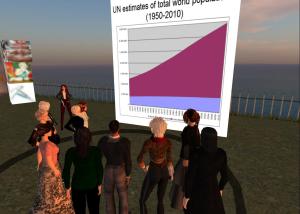
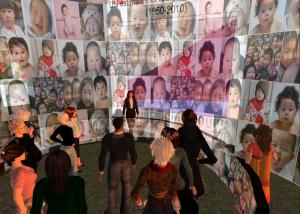
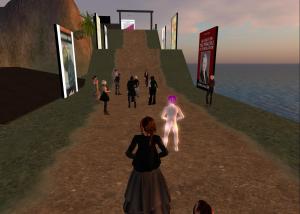
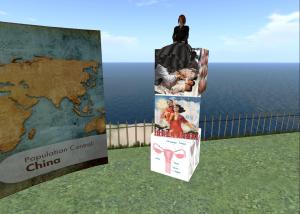
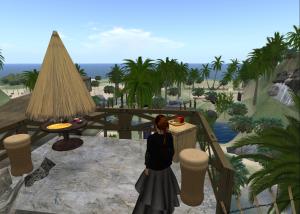
Cool idea! Love the details about implementing and suggestions for change.
Thanks, Kate. It was a really fun event.
Yes, great post. It was a ton of fun and an honor to work with Marloes and everyone on this event.
Chimera Cosmos (aka Liz Dorland)